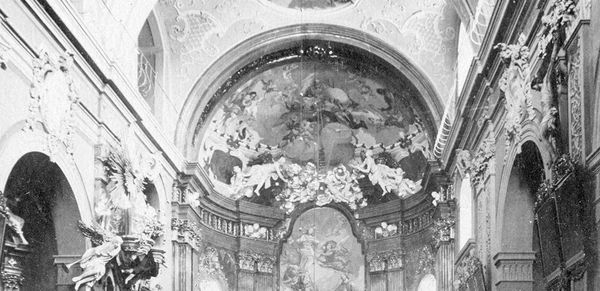Station VII: Main square
Marketplace or: Egon and the stallholders
Here you can find out: Where the people of Tulln went shopping. What the maids wore to the market. Where Gothic and Baroque met. And what the Trinity Column on the main square is supposed to remind us of.
Start of themed circular route: Tulln main station
Distance: 3.6 km
Duration: approx. 90 min.
Difficulty: easy - barrier-free
Schiele Folder EN
Schiele Folder EN
1317: The Hundred Years' War between France and England will not begin for another twenty years. It is the time of the rising bourgeoisie. And the time of the merchants. Tulln is already a central economic hub. The medieval town center is a large marketplace with fountains, sewers and paved paths. The first big fair in the 14th century lasted two weeks and traveling traders came from far and wide. First there is bartering, haggling and peddling. Then there is chatting and partying. Nowhere else can you find out so much about what is happening in the world. Nowhere else are so many rumors spread and gossip stories told.


Brisk trade.
Six hundred years later, trade is still flourishing on Tulln's main square. The Schiele family also sends their maid to the farmers' market. Milk can in hand. The large shopping basket on her arm. She goes from stall to stall. Fresh fruit and vegetables are on offer. And everyday goods. Wooden cooking spoons and iron pans. Polishes for the noble furniture of the manor. And soft soap for the kitchen floor. Later, the housewives come to shop. They haggle with the stallholders, who loudly advertise their wares. Or take a look at the large cattle and pig market, where animals were traded alive until the middle of the 20th century.




[Translate to English:]
Historical architecture.
Another burst of noise occurred with the ringing of the school bell. The primary school pupils came running up soon afterwards. They had no eye for the historical architecture on the main square. A Gothic building was still standing there, the oldest one on the square, with a niche for the city judge’s coat of arms. And there was a Renaissance building with a round corner tower and Venetian crenellations, which once housed a tannery. The little nippers were heading to the Trinity Column. The area around its base was the perfect place for playing tag. It was erected at the end of the 17th century and is meant to commemorate the many plague victims in Tulln. Years later another epidemic would unleash death and destruction: the Spanish flu. It would cause the death of Egon Schiele, his wife and their unborn child.
![[Translate to English:] Tägliches Markttreiben [Translate to English:] Tägliches Markttreiben](/fileadmin/_processed_/f/3/csm_7_Hauptplatz_img302_628px_komp.jpg_3a87ced04a.jpg)
[Translate to English:] Busy daily market


General plan



